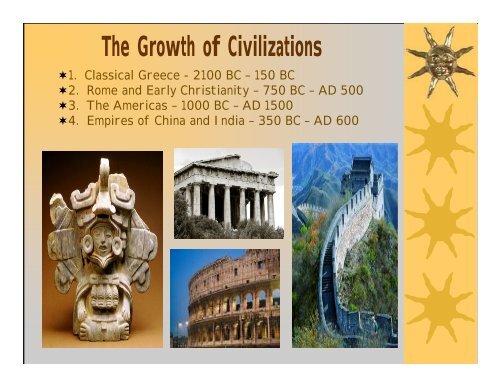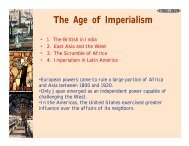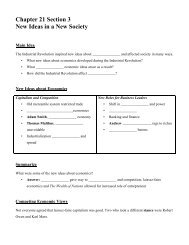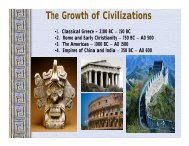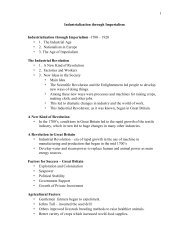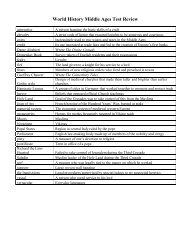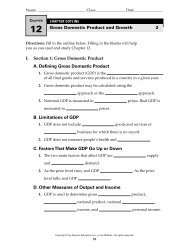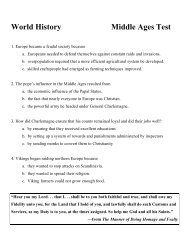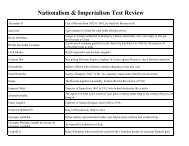1000 BC â AD 1500
1000 BC â AD 1500
1000 BC â AD 1500
Create successful ePaper yourself
Turn your PDF publications into a flip-book with our unique Google optimized e-Paper software.
The Growth of Civilizations<br />
1. Classical Greece - 2100 <strong>BC</strong> – 150 <strong>BC</strong><br />
2. Rome and Early Christianity – 750 <strong>BC</strong> – <strong>AD</strong> 500<br />
3. The Americas – <strong>1000</strong> <strong>BC</strong> – <strong>AD</strong> <strong>1500</strong><br />
4. Empires of China and India – 350 <strong>BC</strong> – <strong>AD</strong> 600
The Americas<br />
<strong>1000</strong> <strong>BC</strong> to Ad <strong>1500</strong><br />
•1. North America<br />
•2. Meso America<br />
•3. South America<br />
•As advanced civilizations developed in Rome, other civilizations<br />
developed in the Americas<br />
•Early American civilizations all found ways to adapt to the varied<br />
environments of the Americas<br />
•Some developed sophisticated governments and engineering that<br />
rivaled those of the ancient Romans
<strong>1000</strong> <strong>BC</strong>- <strong>AD</strong><strong>1500</strong><br />
Early Human Migrations
1. North America<br />
<strong>1000</strong> <strong>BC</strong>- <strong>AD</strong><strong>1500</strong><br />
Kennewick Man – 9,000 year old human<br />
skull found along the Columbia River<br />
Gives us clues to some questions about<br />
early Americans
Cultures of North America<br />
<strong>1000</strong> <strong>BC</strong>- <strong>AD</strong><strong>1500</strong><br />
•Arctic and the Subarctic, Far West, Eastern Woodlands,<br />
Desert West, Great Plains
Cultures of the Desert West<br />
<strong>1000</strong> <strong>BC</strong>- <strong>AD</strong><strong>1500</strong><br />
Hohokam- 300 <strong>BC</strong> to <strong>AD</strong><br />
<strong>1500</strong> –adobe-mixtures of<br />
clay and straw for homes<br />
<br />
Cliff Palace at Mesa Verde<br />
Anasazi cliff dwelling<br />
Anasazi – 100 <strong>BC</strong> to Ad<br />
1300 –adopted the puebloaboveground<br />
structure used<br />
for homes
The Mound Builders<br />
<strong>1000</strong> <strong>BC</strong>- <strong>AD</strong><strong>1500</strong><br />
•Hopewell – 200 <strong>BC</strong> to Ad<br />
500 – some form of<br />
organized labor<br />
Mississippian – built some<br />
of the earliest cities in<br />
North America
Other Cultures in North America<br />
<strong>1000</strong> <strong>BC</strong>- <strong>AD</strong><strong>1500</strong><br />
Inuit – Arctic Region -<br />
no vegetation for foodfishing<br />
instead<br />
The Iroquois – Forest<br />
Environment formed a<br />
confederacy<br />
Plains Indians –<br />
treeless grasslands
Sculpture from the Americas<br />
<strong>1000</strong> <strong>BC</strong>- <strong>AD</strong><strong>1500</strong><br />
• Origins of the Peoples of the Americas?
<strong>1000</strong> <strong>BC</strong>- <strong>AD</strong><strong>1500</strong><br />
The “Mother Culture” of Meso- America<br />
Olmec-predated just about every other civilization in<br />
Meso- America.<br />
First to use writing system and first to use pyramids;<br />
the one to give rise to later cultures in that region.
<strong>1000</strong> <strong>BC</strong>- <strong>AD</strong><strong>1500</strong><br />
2. Meso American Civilizations<br />
•Mayan Aztec
<strong>1000</strong> <strong>BC</strong>- <strong>AD</strong><strong>1500</strong><br />
•The Olmec Civilization was small to the Mayan civilization,<br />
which had its height in <strong>1000</strong> <strong>BC</strong> consisted of 10 million in<br />
over 40 cities.
Lands of the Mayans<br />
<strong>1000</strong> <strong>BC</strong>- <strong>AD</strong><strong>1500</strong><br />
The Yucatan<br />
Peninsula
Mayan Cultivation of Maize<br />
<strong>1000</strong> <strong>BC</strong>- <strong>AD</strong><strong>1500</strong><br />
•Slash and Burn-farming method<br />
•Involves burning vegetation to clear<br />
•It for planting
Chichen-Itza - Pyramid<br />
<strong>1000</strong> <strong>BC</strong>- <strong>AD</strong><strong>1500</strong><br />
•Mayan cities such as Michen-Itza and Tikal were some<br />
of the more spectacular cities, containing pyramids,<br />
temples, and great palaces.
Chichen-Itza - Observatory<br />
<strong>1000</strong> <strong>BC</strong>- <strong>AD</strong><strong>1500</strong><br />
•Mayans made advances in astronomy. They observed the<br />
movements of the sun, moon, and planets. Calendar system<br />
– 365 days farming schedule
Chichen-Itza - Ball Court<br />
<strong>1000</strong> <strong>BC</strong>- <strong>AD</strong><strong>1500</strong>
<strong>1000</strong> <strong>BC</strong>- <strong>AD</strong><strong>1500</strong><br />
Overview of Tikal (Guatemala)<br />
Temple of the Masks
<strong>1000</strong> <strong>BC</strong>- <strong>AD</strong><strong>1500</strong><br />
Tikal Jungle View at Sunset
Tikal - Main Court<br />
<strong>1000</strong> <strong>BC</strong>- <strong>AD</strong><strong>1500</strong><br />
•Mayan cities functioned as city states, each had its own ruler and<br />
government.<br />
•Trade linked the cities.<br />
•Warfare also linked other cities.<br />
•Mayan cities never united.
•Tikal: Temple of the Masks<br />
<strong>1000</strong> <strong>BC</strong>- <strong>AD</strong><strong>1500</strong>
<strong>1000</strong> <strong>BC</strong>- <strong>AD</strong><strong>1500</strong><br />
Tikal - Wall Mask of the Rain God<br />
Chac, God<br />
of Rain
Quetzalcoatl:<br />
<strong>1000</strong> <strong>BC</strong>- <strong>AD</strong><strong>1500</strong><br />
The God of Wisdom & Learning
Mayan Glyphs<br />
<strong>1000</strong> <strong>BC</strong>- <strong>AD</strong><strong>1500</strong><br />
sky king house child city<br />
Mayan<br />
Mathematics<br />
•The Mayans developed a complex writing system, glyphs, or<br />
symbols. They also created a number system, using the<br />
concept of zero for the first time.
Mayan Glyphs<br />
<strong>1000</strong> <strong>BC</strong>- <strong>AD</strong><strong>1500</strong>
<strong>1000</strong> <strong>BC</strong>- <strong>AD</strong><strong>1500</strong><br />
Mayan Underground Granaries: Chultunes
<strong>1000</strong> <strong>BC</strong>- <strong>AD</strong><strong>1500</strong><br />
Mayan Drinking Cup for Chocolate
Pakal: The Maya Astronaut<br />
<strong>1000</strong> <strong>BC</strong>- <strong>AD</strong><strong>1500</strong>
<strong>1000</strong> <strong>BC</strong>- <strong>AD</strong><strong>1500</strong><br />
•The Aztecs, just a small group of farmers from northwest<br />
Mexico, created the most powerful empire in Meso -<br />
America.
Lands of the Aztecs<br />
<strong>1000</strong> <strong>BC</strong>- <strong>AD</strong><strong>1500</strong><br />
•What land did they conquer?
Aztec View of Tenochtitlan<br />
<strong>1000</strong> <strong>BC</strong>- <strong>AD</strong><strong>1500</strong><br />
•The Capital City of the Aztecs. Covered five miles and had a<br />
population of 200,000. One of the largest cities in the world<br />
at the time.
<strong>1000</strong> <strong>BC</strong>- <strong>AD</strong><strong>1500</strong><br />
Tenochtitlan: The “Venice” of the Americas
Aztec Chinampa or Floating Garden:<br />
15ft. to 30ft. wide<br />
<strong>1000</strong> <strong>BC</strong>- <strong>AD</strong><strong>1500</strong>
Tenochtitlan - Chinampas<br />
<strong>1000</strong> <strong>BC</strong>- <strong>AD</strong><strong>1500</strong><br />
•Tenochtitlan was built on swampy island in the middle of a<br />
lake. To create more farm land they build floating gardens
Aztec Writing<br />
<strong>1000</strong> <strong>BC</strong>- <strong>AD</strong><strong>1500</strong><br />
•They kept written<br />
records similar to<br />
Mayans but not as<br />
advanced.<br />
Aztec Math<br />
•They also used<br />
Math. Conquered<br />
People were<br />
required to pay a<br />
tribute, a tax.
Aztec Sun Stone -- Calendar<br />
<strong>1000</strong> <strong>BC</strong>- <strong>AD</strong><strong>1500</strong><br />
•They<br />
created a<br />
260-religious<br />
calendar and<br />
a 365-day<br />
solar<br />
calendar.<br />
They also<br />
calculated<br />
movements of<br />
planets.
The Aztecs Were<br />
<strong>1000</strong> <strong>BC</strong>- <strong>AD</strong><strong>1500</strong><br />
Fierce Warriors<br />
•Achievements in the Arts and Sciences. Artisans made<br />
bright feathers into headdresses, shields, and wartime<br />
costumes. Metalworkers fashioned gold and silver.
Aztec Gold<br />
<strong>1000</strong> <strong>BC</strong>- <strong>AD</strong><strong>1500</strong>
Aztec Sun Motifs<br />
<strong>1000</strong> <strong>BC</strong>- <strong>AD</strong><strong>1500</strong>
Aztecs Sacrifice Neighboring Tribes to<br />
the Sun God-needed human blood<br />
<strong>1000</strong> <strong>BC</strong>- <strong>AD</strong><strong>1500</strong>
Heart Sacrifice<br />
<strong>1000</strong> <strong>BC</strong>- <strong>AD</strong><strong>1500</strong><br />
on an Aztec Temple Pyramid
<strong>1000</strong> <strong>BC</strong>- <strong>AD</strong><strong>1500</strong><br />
Wall of Skulls, Tenochtitlan
Sacrificial Statue, Tenochtitlan<br />
<strong>1000</strong> <strong>BC</strong>- <strong>AD</strong><strong>1500</strong>
<strong>1000</strong> <strong>BC</strong>- <strong>AD</strong><strong>1500</strong><br />
Ruins of the City Center, Tenochtitlan
Aztec Codex<br />
(15c Manuscript)<br />
<strong>1000</strong> <strong>BC</strong>- <strong>AD</strong><strong>1500</strong><br />
•Lasted a short period of time, 200 years. Contact with<br />
the Europeans brought an end to the empire.
<strong>1000</strong> <strong>BC</strong>- <strong>AD</strong><strong>1500</strong><br />
•The Codex<br />
Mendoza :The<br />
Founding of<br />
Tenochtitlantwenty<br />
years after<br />
the Spanish<br />
Conquest it contains<br />
the history of the<br />
city
<strong>1000</strong> <strong>BC</strong>- <strong>AD</strong><strong>1500</strong><br />
3. South America<br />
•Many years after earlier civilizations such as the<br />
Chavin, Moche, and Nazca, the Inca Civilization brought<br />
the entire Andes Mountain region into one empire.
Lands of the Incas<br />
<strong>1000</strong> <strong>BC</strong>- <strong>AD</strong><strong>1500</strong><br />
•They began as a<br />
small tribe in the<br />
Andes, but by the<br />
early <strong>1500</strong>’s their<br />
empire extended<br />
almost the entire<br />
Pacific coast<br />
throughout the<br />
Andes.
Cuzco: Ancient Capital of the Inca<br />
(11,000 ft. above sea level)<br />
<strong>1000</strong> <strong>BC</strong>- <strong>AD</strong><strong>1500</strong>
Machu Picchu<br />
<strong>1000</strong> <strong>BC</strong>- <strong>AD</strong><strong>1500</strong><br />
•Pachacuti –leader of the Inca used political alliances<br />
and military force to gain control.<br />
•The emperor had most of the power.
Machu Picchu<br />
<strong>1000</strong> <strong>BC</strong>- <strong>AD</strong><strong>1500</strong>
Incan Suspension Bridges<br />
<strong>1000</strong> <strong>BC</strong>- <strong>AD</strong><strong>1500</strong><br />
•The first known bridges<br />
spanned cannons, and rivers.<br />
Woven out of fibers and vines.
Incan Terrace Farming<br />
<strong>1000</strong> <strong>BC</strong>- <strong>AD</strong><strong>1500</strong><br />
•Terraces increased the amount of land available for<br />
agriculture.
Incan Digging Sticks<br />
<strong>1000</strong> <strong>BC</strong>- <strong>AD</strong><strong>1500</strong>
The Quipu: An Incan Database<br />
<strong>1000</strong> <strong>BC</strong>- <strong>AD</strong><strong>1500</strong><br />
•Keep track of moving<br />
goods they used set of<br />
colored and knotted<br />
cords.
<strong>1000</strong> <strong>BC</strong>- <strong>AD</strong><strong>1500</strong><br />
Over 100 Different Types of Potatoes<br />
Cultivated<br />
by the Incans
Produce from a Typical Incan<br />
Market<br />
<strong>1000</strong> <strong>BC</strong>- <strong>AD</strong><strong>1500</strong>
Incan Ceramic Jars<br />
<strong>1000</strong> <strong>BC</strong>- <strong>AD</strong><strong>1500</strong><br />
Peanut<br />
Potato<br />
Squash<br />
Cacao God<br />
Cacao Pod
Maize in Incan Pottery<br />
<strong>1000</strong> <strong>BC</strong>- <strong>AD</strong><strong>1500</strong><br />
& Gold Work
Inca Gold & Silver<br />
<strong>1000</strong> <strong>BC</strong>- <strong>AD</strong><strong>1500</strong><br />
•Artisans made intricate ornaments out<br />
of gold and silver.
Incan Mummies<br />
<strong>1000</strong> <strong>BC</strong>- <strong>AD</strong><strong>1500</strong><br />
•The Incas lasted only<br />
about 100 years.<br />
•The arrival of the<br />
Spanish in Peru in 1532<br />
marked the end.


